spare wheel MITSUBISHI L200 2018 Owner's Manual (in English)
[x] Cancel search | Manufacturer: MITSUBISHI, Model Year: 2018, Model line: L200, Model: MITSUBISHI L200 2018Pages: 466, PDF Size: 28.42 MB
Page 14 of 466

Exterior - rearE085004025921. Tyre inflation pressures p. 10-12Changing tyres p. 8-17
Tyre rotation p. 10-13
Snow tyres p. 10-14
Tyre chains p. 10-14
2. Tail and stop lamps p. 5-17, 10-23, 10-28
3. Rear turn-signal lamps p. 5-20, 10-23, 10-28
4. Reversing lamps p. 10-23, 10-28 Rear fog lamp (driver’s side) p. 5-22, 10-23, 10-28
5. Spare wheel p. 8-17
6. Licence plate lamp p. 5-16, 10-23, 10-29
7. Rear gate p. 3-20
8. High-mounted stop lamp p. 10-23
Exterior - rear
1-12OKTE18E1Overview/Quick guide1Single cab
Page 15 of 466
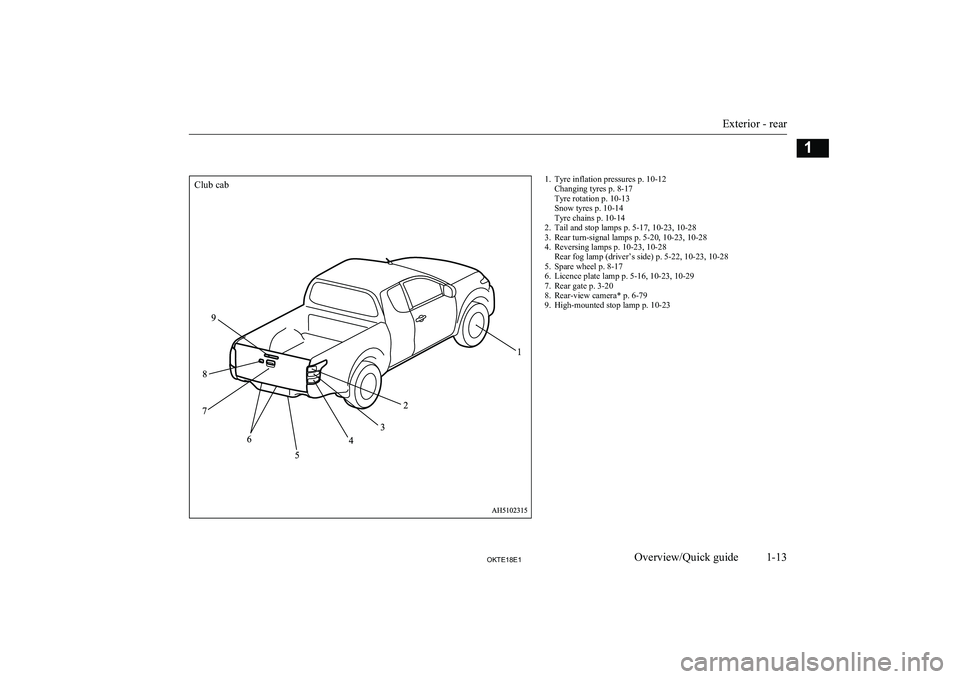
1. Tyre inflation pressures p. 10-12Changing tyres p. 8-17
Tyre rotation p. 10-13
Snow tyres p. 10-14
Tyre chains p. 10-14
2. Tail and stop lamps p. 5-17, 10-23, 10-28
3. Rear turn-signal lamps p. 5-20, 10-23, 10-28
4. Reversing lamps p. 10-23, 10-28 Rear fog lamp (driver’s side) p. 5-22, 10-23, 10-28
5. Spare wheel p. 8-17
6. Licence plate lamp p. 5-16, 10-23, 10-29
7. Rear gate p. 3-20
8. Rear-view camera* p. 6-79
9. High-mounted stop lamp p. 10-23
Exterior - rear
1-13OKTE18E1Overview/Quick guide1Club cab
Page 16 of 466
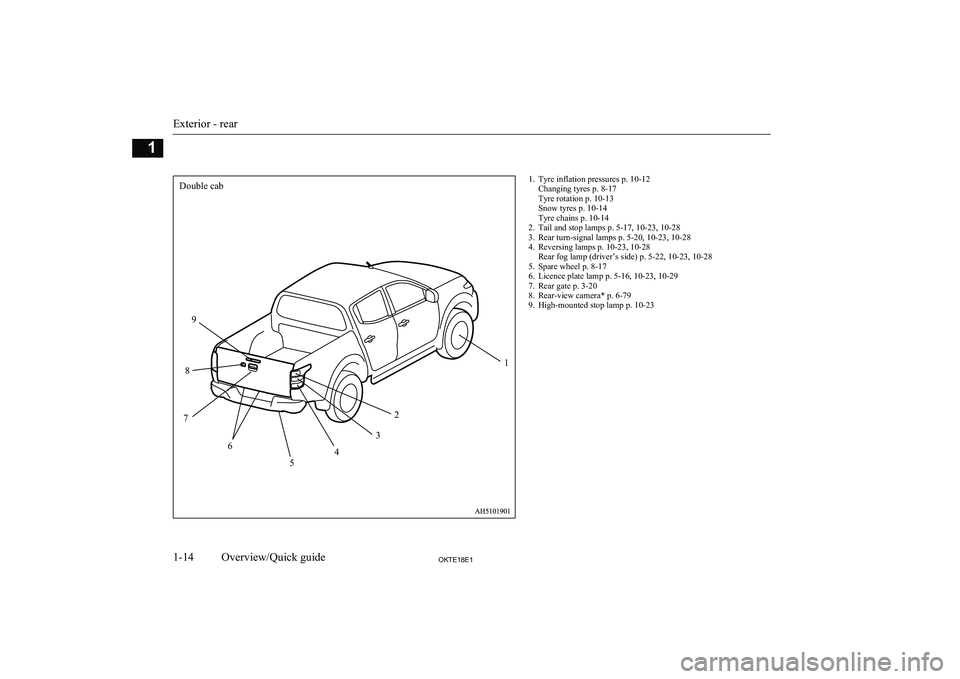
1. Tyre inflation pressures p. 10-12Changing tyres p. 8-17
Tyre rotation p. 10-13
Snow tyres p. 10-14
Tyre chains p. 10-14
2. Tail and stop lamps p. 5-17, 10-23, 10-28
3. Rear turn-signal lamps p. 5-20, 10-23, 10-28
4. Reversing lamps p. 10-23, 10-28 Rear fog lamp (driver’s side) p. 5-22, 10-23, 10-28
5. Spare wheel p. 8-17
6. Licence plate lamp p. 5-16, 10-23, 10-29
7. Rear gate p. 3-20
8. Rear-view camera* p. 6-79
9. High-mounted stop lamp p. 10-23
Exterior - rear
1-14OKTE18E1Overview/Quick guide11
2
3
4
5
6
7 8 9
Double cab
Page 331 of 466
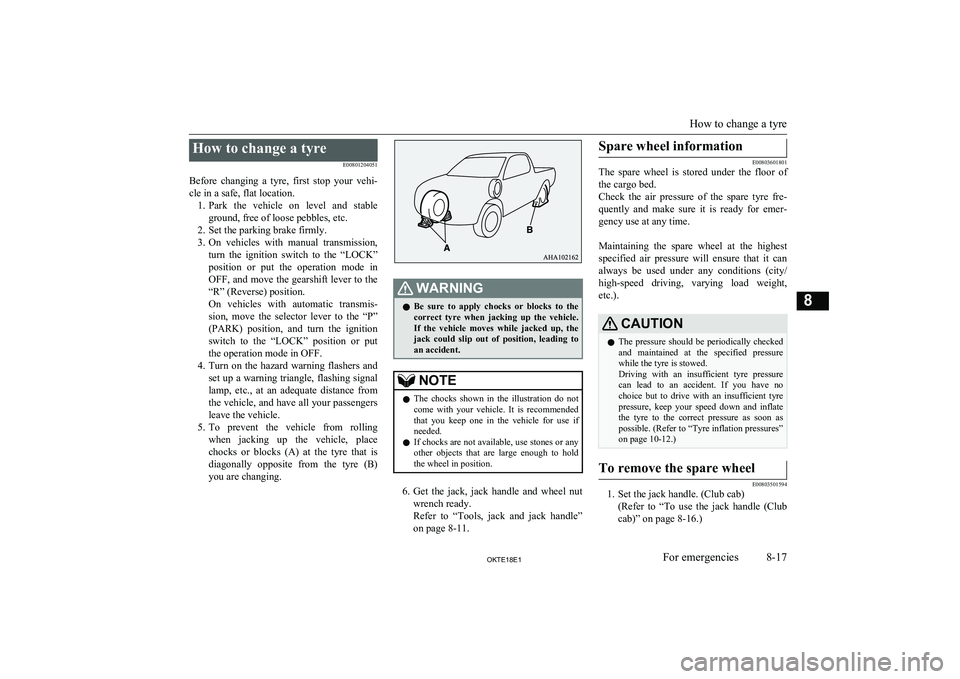
How to change a tyreE00801204051
Before changing a tyre, first stop your vehi- cle in a safe, flat location. 1. Park the vehicle on level and stable
ground, free of loose pebbles, etc.
2. Set the parking brake firmly.
3. On vehicles with manual transmission,
turn the ignition switch to the “LOCK”
position or put the operation mode in
OFF, and move the gearshift lever to the
“R” (Reverse) position.
On vehicles with automatic transmis- sion, move the selector lever to the “P” (PARK) position, and turn the ignitionswitch to the “LOCK” position or put
the operation mode in OFF.
4. Turn on the hazard warning flashers and
set up a warning triangle, flashing signal
lamp, etc., at an adequate distance from
the vehicle, and have all your passengers
leave the vehicle.
5. To prevent the vehicle from rolling
when jacking up the vehicle, placechocks or blocks (A) at the tyre that is
diagonally opposite from the tyre (B)
you are changing.WARNINGl Be sure to apply chocks or blocks to the
correct tyre when jacking up the vehicle.If the vehicle moves while jacked up, the
jack could slip out of position, leading to
an accident.NOTEl The chocks shown in the illustration do not
come with your vehicle. It is recommended
that you keep one in the vehicle for use if needed.
l If chocks are not available, use stones or any
other objects that are large enough to hold the wheel in position.
6. Get the jack, jack handle and wheel nut
wrench ready.
Refer to “Tools, jack and jack handle” on page 8-11.
Spare wheel information
E00803601801
The spare wheel is stored under the floor of
the cargo bed.
Check the air pressure of the spare tyre fre-
quently and make sure it is ready for emer- gency use at any time.
Maintaining the spare wheel at the highest
specified air pressure will ensure that it can always be used under any conditions (city/ high-speed driving, varying load weight,
etc.).
CAUTIONl The pressure should be periodically checked
and maintained at the specified pressure while the tyre is stowed.
Driving with an insufficient tyre pressure
can lead to an accident. If you have no choice but to drive with an insufficient tyre
pressure, keep your speed down and inflate the tyre to the correct pressure as soon as
possible. (Refer to “Tyre inflation pressures”
on page 10-12.)To remove the spare wheel
E00803501594
1. Set the jack handle. (Club cab)
(Refer to “To use the jack handle (Clubcab)” on page 8-16.)
How to change a tyre
8-17OKTE18E1For emergencies8
Page 332 of 466
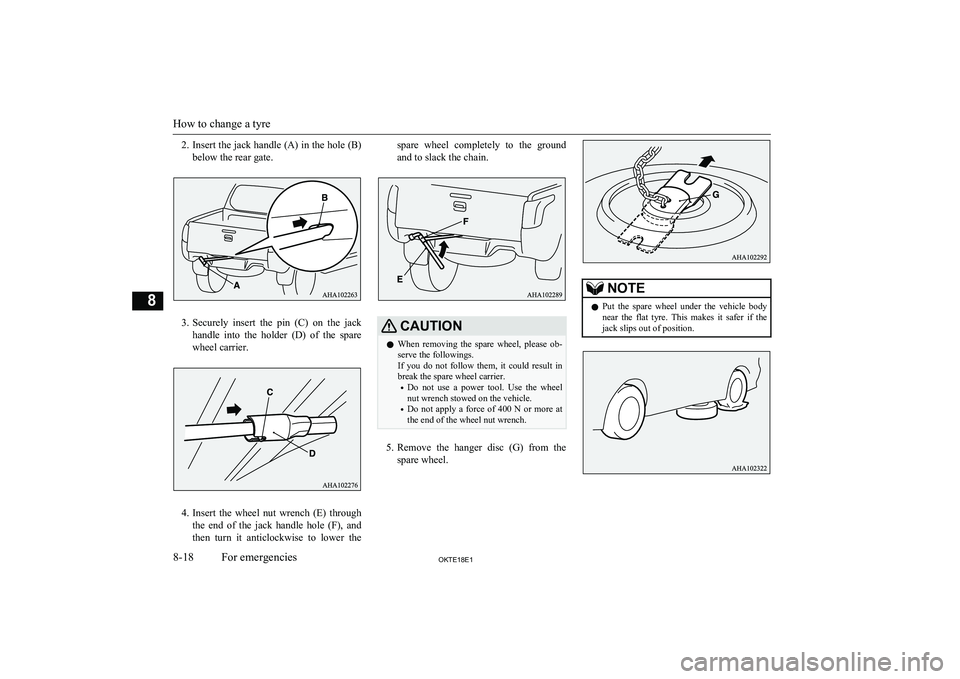
2.Insert the jack handle (A) in the hole (B)
below the rear gate.
3. Securely insert the pin (C) on the jack
handle into the holder (D) of the spare
wheel carrier.
4. Insert the wheel nut wrench (E) through
the end of the jack handle hole (F), and
then turn it anticlockwise to lower the
spare wheel completely to the ground
and to slack the chain.CAUTIONl When removing the spare wheel, please ob-
serve the followings.
If you do not follow them, it could result in
break the spare wheel carrier.
• Do not use a power tool. Use the wheel
nut wrench stowed on the vehicle.
• Do not apply a force of 400 N or more at
the end of the wheel nut wrench.
5. Remove the hanger disc (G) from the
spare wheel.
NOTEl Put the spare wheel under the vehicle body
near the flat tyre. This makes it safer if the jack slips out of position.
How to change a tyre
8-18OKTE18E1For emergencies8
Page 334 of 466
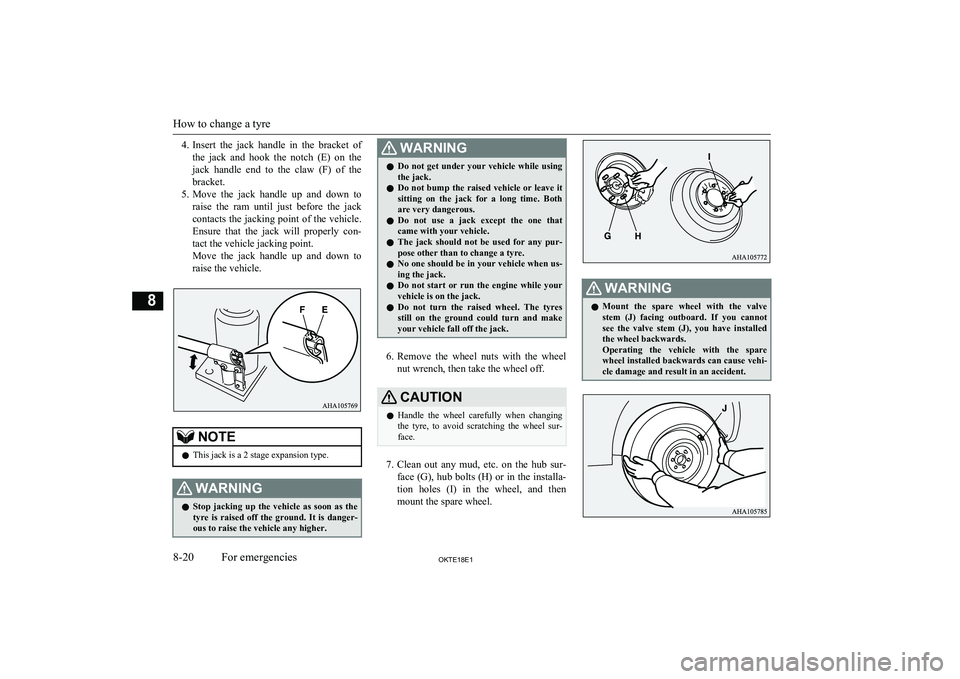
4.Insert the jack handle in the bracket of
the jack and hook the notch (E) on the
jack handle end to the claw (F) of the
bracket.
5. Move the jack handle up and down to
raise the ram until just before the jack
contacts the jacking point of the vehicle.
Ensure that the jack will properly con- tact the vehicle jacking point.
Move the jack handle up and down to raise the vehicle.NOTEl This jack is a 2 stage expansion type.WARNINGlStop jacking up the vehicle as soon as the
tyre is raised off the ground. It is danger-
ous to raise the vehicle any higher.WARNINGl Do not get under your vehicle while using
the jack.
l Do not bump the raised vehicle or leave it
sitting on the jack for a long time. Both
are very dangerous.
l Do not use a jack except the one that
came with your vehicle.
l The jack should not be used for any pur-
pose other than to change a tyre.
l No one should be in your vehicle when us-
ing the jack.
l Do not start or run the engine while your
vehicle is on the jack.
l Do not turn the raised wheel. The tyres
still on the ground could turn and make your vehicle fall off the jack.
6. Remove the wheel nuts with the wheel
nut wrench, then take the wheel off.
CAUTIONl Handle the wheel carefully when changing
the tyre, to avoid scratching the wheel sur- face.
7. Clean out any mud, etc. on the hub sur-
face (G), hub bolts (H) or in the installa- tion holes (I) in the wheel, and then
mount the spare wheel.
WARNINGl Mount the spare wheel with the valve
stem (J) facing outboard. If you cannot see the valve stem (J), you have installed the wheel backwards.
Operating the vehicle with the spare
wheel installed backwards can cause vehi-
cle damage and result in an accident.
How to change a tyre
8-20OKTE18E1For emergencies8
Page 335 of 466
![MITSUBISHI L200 2018 Owners Manual (in English) 8.Turn the wheel nuts clockwise by hand
to initially tighten them.
[Type 1: On vehicles with steel wheels]
Temporarily tighten the wheel nuts by hand until the tapered parts of the w MITSUBISHI L200 2018 Owners Manual (in English) 8.Turn the wheel nuts clockwise by hand
to initially tighten them.
[Type 1: On vehicles with steel wheels]
Temporarily tighten the wheel nuts by hand until the tapered parts of the w](/img/19/34879/w960_34879-334.png)
8.Turn the wheel nuts clockwise by hand
to initially tighten them.
[Type 1: On vehicles with steel wheels]
Temporarily tighten the wheel nuts by hand until the tapered parts of the wheel nuts make light contact with the seats of the wheel holes and the wheel is not
loose.
[Type 2: On vehicles with aluminium wheels]
Temporarily tighten the wheel nuts by
hand until the flange parts of the wheel nuts make light contact with the wheel
and the wheel is not loose.NOTEl Flange nuts can be temporarily used on the
steel spare wheel as shown in the illustra- tion, but return to the original wheel and tyre
as soon as possible.CAUTIONl Never apply oil to either the wheel bolts or
the nuts, or they will tighten too much.NOTEl If all 4 aluminium wheels are changed to
steel wheels. e. g. when fitting winter tyres,
use tapered nuts.
9. Put the notch (K) provided on the jack
handle end on the valve (L) of the jack.
Using the jack handle, turn the release valve anticlockwise slowly to lower thevehicle until the tyre touches the ground.
WARNINGl Be sure to open the release valve slowly. If
it is opened quickly, the vehicle will drop
abruptly and the jack may come out of
position, causing a serious accident.
10. Tighten the nuts crisscross in 2 or 3
steps until each nut has been tightened securely.
How to change a tyre
8-21OKTE18E1For emergencies8Type 1 Type 2
Page 337 of 466
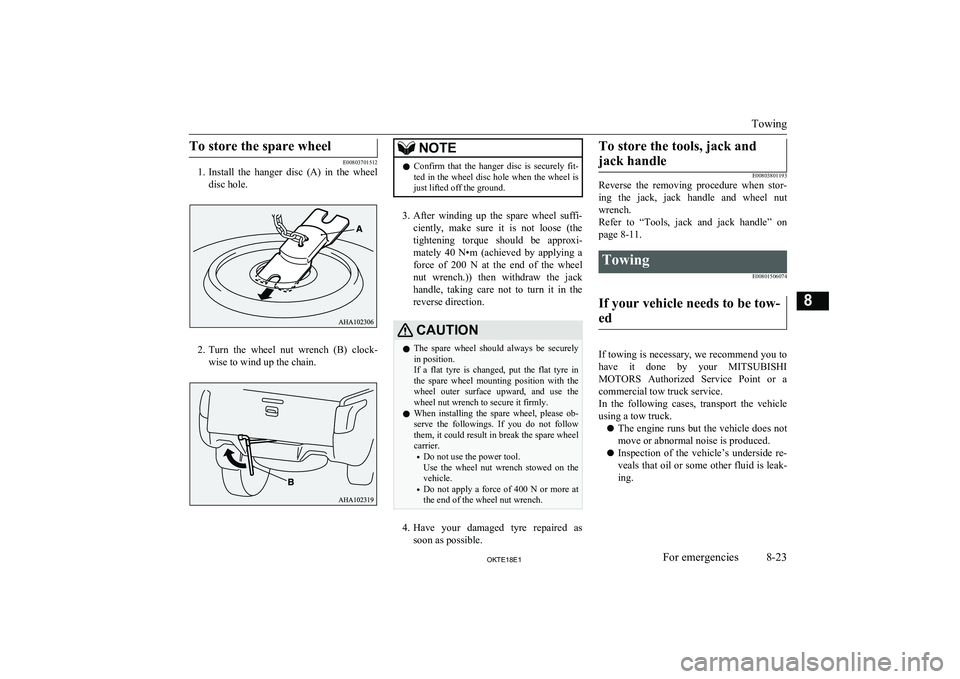
To store the spare wheel
E00803701512
1. Install the hanger disc (A) in the wheel
disc hole.
2. Turn the wheel nut wrench (B) clock-
wise to wind up the chain.
NOTEl Confirm that the hanger disc is securely fit-
ted in the wheel disc hole when the wheel isjust lifted off the ground.
3. After winding up the spare wheel suffi-
ciently, make sure it is not loose (the tightening torque should be approxi-
mately 40 N•m (achieved by applying a force of 200 N at the end of the wheel nut wrench.)) then withdraw the jack
handle, taking care not to turn it in the
reverse direction.
CAUTIONl The spare wheel should always be securely
in position.
If a flat tyre is changed, put the flat tyre in
the spare wheel mounting position with the wheel outer surface upward, and use the wheel nut wrench to secure it firmly.
l When installing the spare wheel, please ob-
serve the followings. If you do not follow
them, it could result in break the spare wheel
carrier.
• Do not use the power tool.
Use the wheel nut wrench stowed on the vehicle.
• Do not apply a force of 400 N or more at
the end of the wheel nut wrench.
4. Have your damaged tyre repaired as
soon as possible.
To store the tools, jack and
jack handle
E00803801193
Reverse the removing procedure when stor-
ing the jack, jack handle and wheel nut
wrench.
Refer to “Tools, jack and jack handle” on page 8-11.
Towing
E00801506074
If your vehicle needs to be tow-
ed
If towing is necessary, we recommend you to have it done by your MITSUBISHI
MOTORS Authorized Service Point or a
commercial tow truck service.
In the following cases, transport the vehicle
using a tow truck.
l The engine runs but the vehicle does not
move or abnormal noise is produced.
l Inspection of the vehicle’s underside re-
veals that oil or some other fluid is leak- ing.
Towing
8-23OKTE18E1For emergencies8
Page 347 of 466
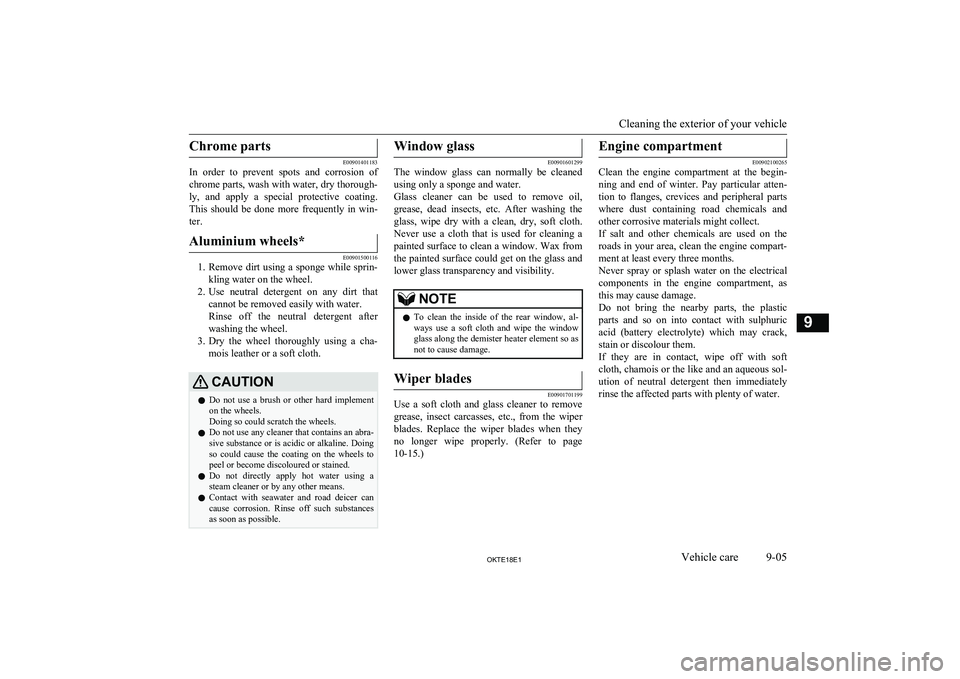
Chrome parts
E00901401183
In order to prevent spots and corrosion of
chrome parts, wash with water, dry thorough- ly, and apply a special protective coating.
This should be done more frequently in win- ter.
Aluminium wheels*
E00901500116
1. Remove dirt using a sponge while sprin-
kling water on the wheel.
2. Use neutral detergent on any dirt that
cannot be removed easily with water.
Rinse off the neutral detergent after
washing the wheel.
3. Dry the wheel thoroughly using a cha-
mois leather or a soft cloth.
CAUTIONl Do not use a brush or other hard implement
on the wheels.
Doing so could scratch the wheels.
l Do not use any cleaner that contains an abra-
sive substance or is acidic or alkaline. Doingso could cause the coating on the wheels topeel or become discoloured or stained.
l Do not directly apply hot water using a
steam cleaner or by any other means.
l Contact with seawater and road deicer can
cause corrosion. Rinse off such substances
as soon as possible.Window glass
E00901601299
The window glass can normally be cleaned
using only a sponge and water.
Glass cleaner can be used to remove oil, grease, dead insects, etc. After washing the
glass, wipe dry with a clean, dry, soft cloth. Never use a cloth that is used for cleaning a
painted surface to clean a window. Wax from
the painted surface could get on the glass and lower glass transparency and visibility.
NOTEl To clean the inside of the rear window, al-
ways use a soft cloth and wipe the window
glass along the demister heater element so as not to cause damage.Wiper blades
E00901701199
Use a soft cloth and glass cleaner to remove
grease, insect carcasses, etc., from the wiper blades. Replace the wiper blades when they
no longer wipe properly. (Refer to page 10-15.)
Engine compartment
E00902100265
Clean the engine compartment at the begin-
ning and end of winter. Pay particular atten- tion to flanges, crevices and peripheral parts where dust containing road chemicals and
other corrosive materials might collect.
If salt and other chemicals are used on the roads in your area, clean the engine compart- ment at least every three months.
Never spray or splash water on the electrical
components in the engine compartment, as
this may cause damage.
Do not bring the nearby parts, the plastic parts and so on into contact with sulphuric
acid (battery electrolyte) which may crack,
stain or discolour them.
If they are in contact, wipe off with soft cloth, chamois or the like and an aqueous sol-
ution of neutral detergent then immediately rinse the affected parts with plenty of water.
Cleaning the exterior of your vehicle
9-05OKTE18E1Vehicle care9
Page 362 of 466
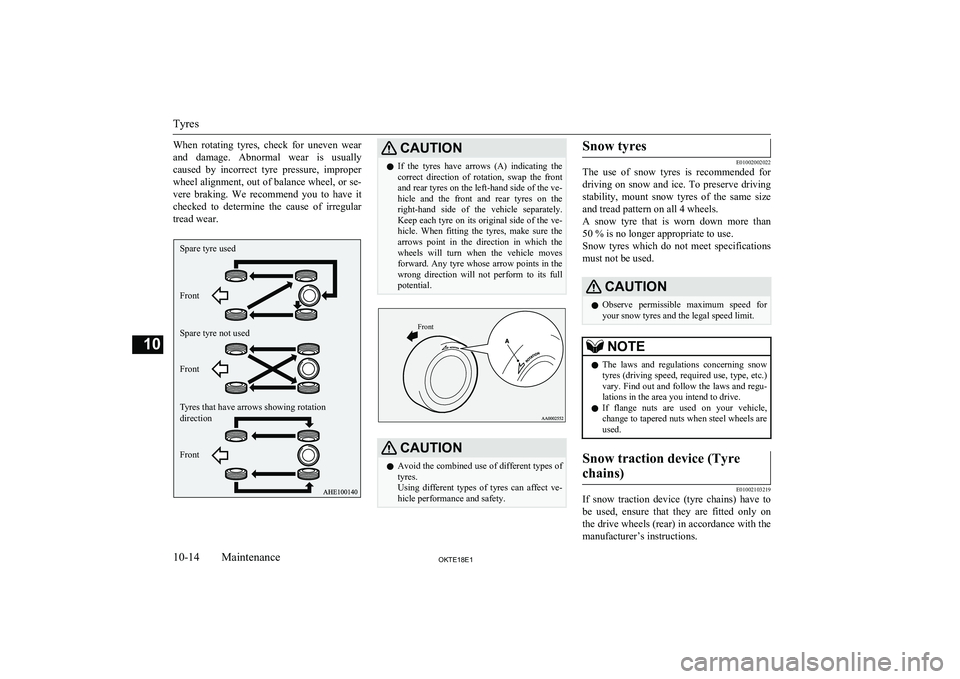
When rotating tyres, check for uneven wear
and damage. Abnormal wear is usually caused by incorrect tyre pressure, improper wheel alignment, out of balance wheel, or se-
vere braking. We recommend you to have it checked to determine the cause of irregular
tread wear.CAUTIONl If the tyres have arrows (A) indicating the
correct direction of rotation, swap the front
and rear tyres on the left-hand side of the ve- hicle and the front and rear tyres on the right-hand side of the vehicle separately.
Keep each tyre on its original side of the ve- hicle. When fitting the tyres, make sure the
arrows point in the direction in which the wheels will turn when the vehicle moves
forward. Any tyre whose arrow points in the wrong direction will not perform to its fullpotential.Front
CAUTIONl Avoid the combined use of different types of
tyres.
Using different types of tyres can affect ve-
hicle performance and safety.Snow tyres
E01002002022
The use of snow tyres is recommended for
driving on snow and ice. To preserve driving stability, mount snow tyres of the same size and tread pattern on all 4 wheels.
A snow tyre that is worn down more than
50 % is no longer appropriate to use.
Snow tyres which do not meet specifications must not be used.
CAUTIONl Observe permissible maximum speed for
your snow tyres and the legal speed limit.NOTEl The laws and regulations concerning snow
tyres (driving speed, required use, type, etc.)
vary. Find out and follow the laws and regu- lations in the area you intend to drive.
l If flange nuts are used on your vehicle,
change to tapered nuts when steel wheels are used.Snow traction device (Tyre
chains)
E01002103219
If snow traction device (tyre chains) have to
be used, ensure that they are fitted only on
the drive wheels (rear) in accordance with the manufacturer’s instructions.
Tyres
10-14OKTE18E1Maintenance10Spare tyre used
Front
Spare tyre not used
Front
Tyres that have arrows showing rotation
direction
Front